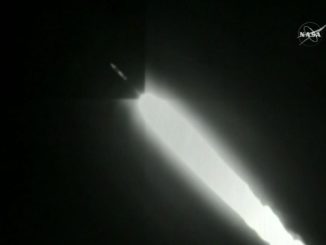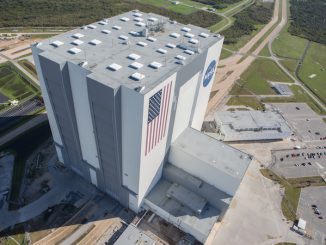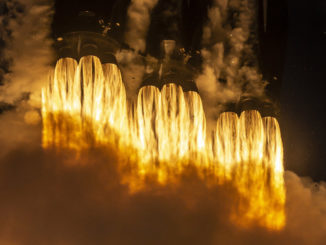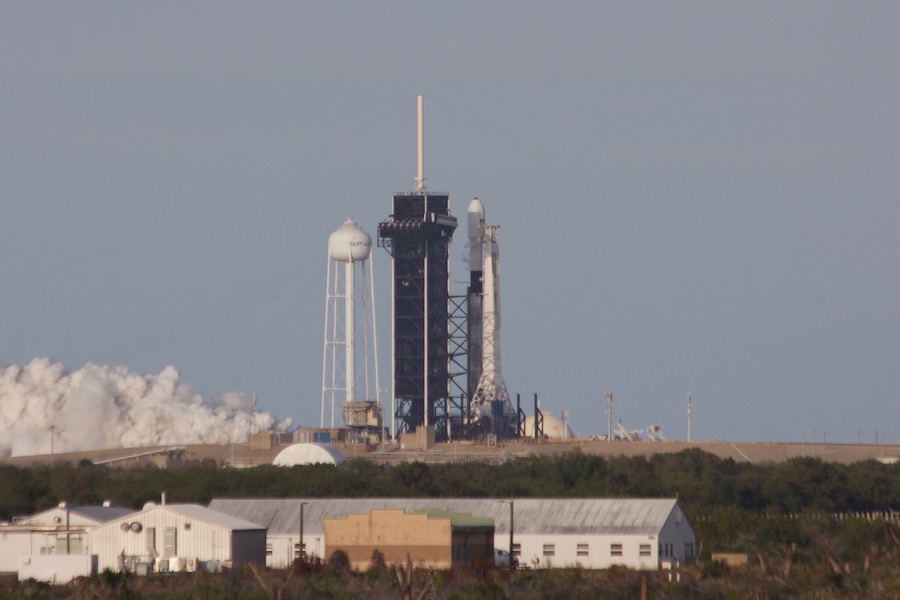
The launch of 60 Starlink Internet satellites aboard a Falcon 9 rocket Sunday from the Kennedy Space Center in Florida will mark SpaceX’s first mission to fly a Falcon first stage for a fifth time, and the second to launch with a reused payload fairing.
SpaceX confirmed the hardware assignments after a successful test-firing of the Falcon 9 rocket’s nine Merlin 1D main engines Friday on pad 39A at NASA’s Kennedy Space Center in Florida.
After filling the Falcon 9 with super-chilled, densified kerosene and liquid oxygen, SpaceX ignited the rocket’s engines at 6:30 p.m. EDT (2230 GMT) Friday as hold-down clamps kept the launcher firmly on the ground. The engines fired for several seconds before shutting down, then SpaceX drained propellants from the Falcon 9.
Liftoff of SpaceX’s sixth mission of the year is scheduled for 9:22 a.m. EDT (1322 GMT) Sunday from pad 39A. With the 60 Starlink satellites fastened on top of the Falcon 9 for launch Sunday, SpaceX will have deployed 360 of the quarter-ton flat-panel spacecraft since last May.
SpaceX plans to launch more than 1,500 Starlink satellites to begin worldwide Internet service, and the Starlink missions are expected to take up the lion’s share of SpaceX’s launch schedule this year.
Three of SpaceX’s five Falcon 9 launches so far this year have been dedicated to the Starlink network, and Sunday’s flight will be the fourth.
The Falcon 9’s first stage booster assigned to Sunday’s mission will be making its fifth flight, SpaceX said Friday. The boosters are designed for 10 flights before a major overhaul, but SpaceX’s first stages have flown no more than four times to date.
The booster, designated B1048, previously launched in July and October 2018 from Vandenberg Air Force Base in California, then twice from Cape Canaveral in February and November 2019. After each mission, SpaceX recovered the booster with landings on drone ships and at an onshore landing pad at Vandenberg.
The payload fairing for Sunday’s mission is flying for the second time. SpaceX retrieved the aerodynamic shroud from the Atlantic Ocean after a previous Starlink launch last May.
SpaceX began re-flying the fairing, which protects satellites from aerodynamic forces during the initial phase of launch, on a Starlink launch in November. The fairing separates in two halves, using cold gas thrusters and a parafoil to guide its descent back to Earth.
A drone ship and two fairing recovery vessels have been dispatched from Port Canaveral to retrieve the first stage and fairing halves again after Sunday’s mission.
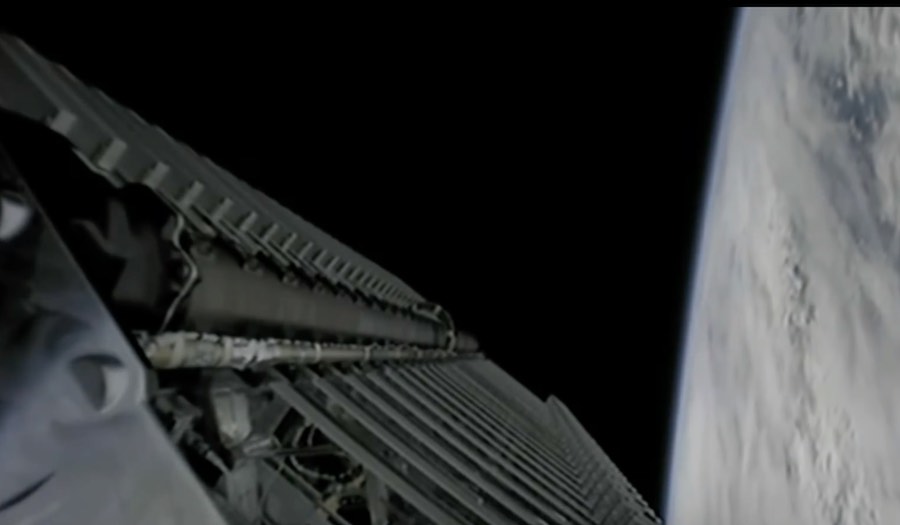
SpaceX, founded in billionaire entrepreneur Elon Musk in 2002, has become a leader in the commercial launch market with its Falcon 9 and Falcon Heavy rockets, thanks in large part to the company’s ability to cut the cost of access to space. The company is developing a pair of next-generation vehicles called the Starship and the Super Heavy booster to replace the Falcon rocket family.
Musk has said revenue from SpaceX’s business will help fund development of the Starship and other future technology needed to carry people to Mars and other planetary destinations.
“The whole purpose of SpaceX is really to help make life multi-planetary, but the revenue potential of launching satellites, servicing the space station and whatnot, that taps out about $3 billion a year,” Musk said March 9 in a talk at the Satellite 2020 conference in Washington. “But I think providing broadband is more like an order of magnitude beyond that, probably $30 billion a year as a rough approximation. And we’re still probably below 5 percent (market share) at that point.”
Musk said the Starlink network will reach the “hardest to serve” Internet customers, and will not be a major threat to established telecom operators.
“It’s not like Starlink is some real threat to teclos,” he said.
The first phase of the Starlink network will include more than 1,500 satellites — including spares — orbiting 341 miles (550 kilometers) above Earth on tracks inclined 53 degrees to the equator. But SpaceX has regulatory authority from the Federal Communications Commission to operate up to 12,000 communications and data relay spacecraft.
“5G is great for high-density situations like being here in D.C. or New York, San Francisco, that kind of thing,” Musk said. “But it’s actually not great for the countryside. For rural areas, it’s not great. You need range. So any kind of sparse environment, 5G is really not well-suited, but it’s great for dense city situations.
“So Starlink will effectively service the 3 or 4 percent hardest to reach customers for telcos, or people who simply have no connectivity right now, or the connectivity is really bad,” Musk said. “So I think it will be actually helpful and take a significant load off the traditional telcos.”
The U.S. military could also be a major customer for Starlink services.
SpaceX has not publicized connectivity speeds or prices for consumer-grade connectivity through the Starlink network. But Musk gate prospective customers a taste of what they could expect.
“It will be very low latency, and we’re targeting latency below 20 milliseconds, so somebody could play a fast response video game at a competitive level,” he said. “That’s the threshold for latency. And bandwidth? The bandwidth is a very complex question. Let’s just say somebody will be able to watch high-definition movies, play video games, and do all the things they want to do without noticing speed.”
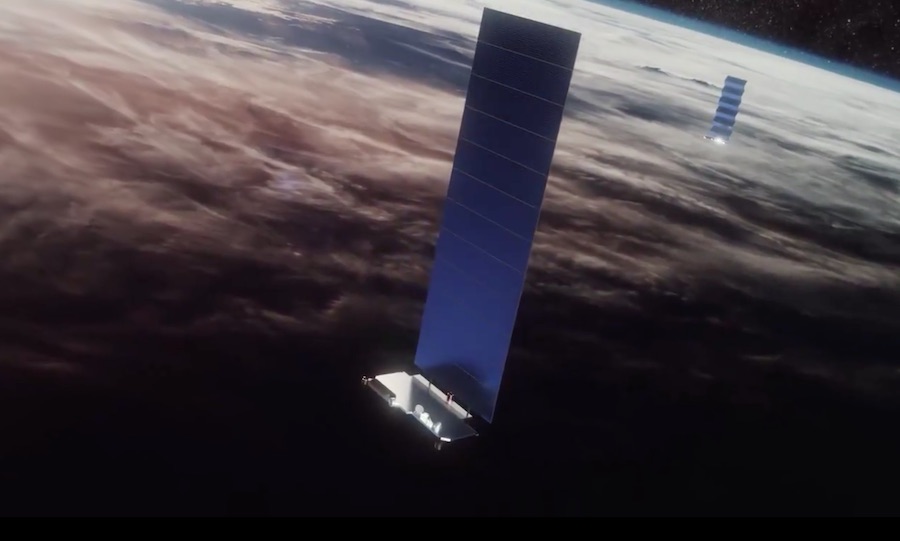
Musk said user ground terminals will “look like a UFO on a stick,” and the first version of the Starlink ground antenna will have actuators to point the transmitter and receiver.
“It’s very important that you don’t need a specialist to install,” Musk said. “The goal is that (on) the instructions on the box, there are just two instructions, and they can be done in either order: Point at sky and plug in.”
Many astronomers are worried that the launch of thousands of satellites, such as those planned by SpaceX and competitors like OneWeb and Amazon, will impact observations of the night sky.
SpaceX’s Starlink satellites are brighter than expected, particularly soon after a launch when the spacecraft are clumped together in clusters at lower altitudes. Reflective surfaces on the satellites glint sunlight back to Earth’s surface near dawn and dusk.
The European Southern Observatory reported March 5 that its Very Large Telescope and future Extremely Large Telescope in Chile will be ‘moderately affected’ by the satellite constellations under development. About 3 percent of long exposures from the telescopes could be ruined at twilight, the scientists concluded in a study accepted for publication in the scientific journal Astronomy & Astrophysics.
But other facilities may not be so fortunate.
“The study also finds that the greatest impact could be on wide-field surveys, in particular those done with large telescopes,” ESO said in a statement. “For example, up to 30 percent to 50 percent of exposures with the U.S. National Science Foundation’s Vera C. Rubin Observatory … would be ‘severely affected,’ depending on the time of year, the time of night, and the simplifying assumptions of the study.
“Mitigation techniques that could be applied on ESO telescopes would not work for this observatory although other strategies are being actively explored,” ESO said.
Musk dismissed those concerns March 9.
“I’m confident that we will not cause impact whatsoever in astronomical discoveries,” he said. “Zero. That’s my prediction. We’ll take corrective action if it’s above zero.
“When the satellites are first launched, they’re tumbling a little bit, so they’re going to glint because they haven’t stabilized. And they are raising their orbits, so they’re lower than you’d expect, and they reflect in ways that is not the case when they’re on orbit.”
SpaceX and OneWeb are working with scientists to mitigate the effects of satellite constellations on astronomical observations.
“So we’re running a bunch of experiments to, for example, paint the phased array antenna black instead of white,” Musk said. “And we’re working on a sunshade because there are certain angles if the sun get just right and there’s not, like, a little sunshade — we’re not talking about a lot here — then you can get a reflection. So we’re launching sunshade, changing the color of the satellites, and otherwise minimizing the potential for any impact.”
SpaceX said last month it was considering spinning off the Starlink business into a separate company, and potentially launch a public stock offering in the project, in the next several years.
Musk said March 9 that SpaceX is focused on making Starlink successful first.
“We’re thinking about that zero,” he said. “We need to make the thing work.”
Guess how many LEO (low Earth orbit) constellations didn’t go bankrupt? Zero. Iridium’s doing OK (now), but Iridium 1 went bankrupt. Orbcomm went bankrupt. Globalstar, bankrupt. Teledesic, bankrupt.”
He said there’s room for other companies in the market to provide Internet services from space, and SpaceX is happy to launch satellites for competitors. SES, a longtime SpaceX customer, announced last year it would launch seven high-power broadband satellites for its O3b mPower network on two Falcon 9 rocket flights.
“If you want to launch a constellation on SpaceX, that sounds good to me,” he said. “The world seems to have an insatiable appetite for bandwidth … We don’t think Starlink is going to destroy all other satellites, or something like that.”
Email the author.
Follow Stephen Clark on Twitter: @StephenClark1.

